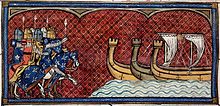| Battle of Damme | |||||||
|---|---|---|---|---|---|---|---|
| Part of the Anglo-French War (1213–14) | |||||||
 Philip II awaits his fleet | |||||||
| |||||||
| Belligerents | |||||||
| Kingdom of France |
Kingdom of England County of Flanders | ||||||
| Commanders and leaders | |||||||
| Savari de Mauléon | William Longespée, 3rd Earl of Salisbury | ||||||
| Strength | |||||||
| Unknown, but large | Unknown | ||||||
| Casualties and losses | |||||||
| 300 ships captured, over 100 burned; remaining ships scuttled. | Unknown | ||||||
The Battle of Damme was fought on 30 and 31 May 1213 during the 1213–1214 Anglo-French War. An English fleet led by William Longespée, Earl of Salisbury accidentally encountered a large French fleet under the command of Savari de Mauléon in the vicinity of the port of Damme, in Flanders. The French crews were mostly ashore, pillaging the countryside, and the English captured 300 French ships at anchor, and looted and fired a further hundred beached ships. The main French army, commanded by King Philip II of France, was nearby besieging Ghent and it promptly marched on Damme. It arrived in time to relieve the town's French garrison and drive off the English landing parties. Philip had the remainder of the French fleet burned to avoid capture. The success of the English raid yielded immense booty and ended the immediate threat of a French invasion of England. It is often considered the first great naval victory in English history.